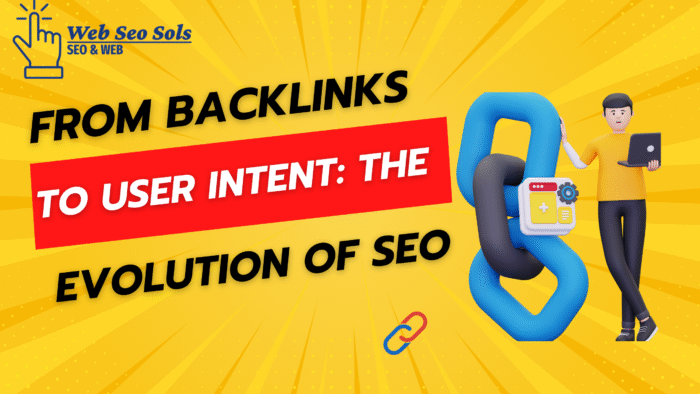The landscape of Search Engine Optimization (SEO) has undergone profound transformations since the genesis of the internet, adapting to the ever-changing needs and behaviours of users. Initially marked by a heavy reliance on backlinks as a primary ranking factor, SEO has gradually evolved into a more nuanced discipline that emphasizes user intent, experience, and the holistic quality of content. This essay explores the evolution of SEO from its roots in backlinks to its current focus on understanding user intent, elucidating the implications for digital marketers and content creators alike.
The Era of Backlinks and Manipulative Tactics
In the early days of search engines, particularly during the late 1990s and early 2000s, the SEO paradigm was largely dominate by backlinks. Search algorithms relied heavily on the quantity and quality of links pointing to a website as a major indicator of its relevance and authority.
Marketers employed techniques like link building, article submissions, and directory listings to enhance a website’s backlink profile, often at the expense of content quality and user experience. This created a landscape rife with manipulation, as businesses utilized tactics to game the system rather than genuinely engage with their audiences. Such strategies, although effective at the time, ultimately resulted in a degradation of the quality of search engine results.
The Shift to Quality and Relevance
Recognizing the limitations of a backlink-centric approach, search engines began to refine their algorithms to prioritize content relevance and quality. The introduction of Google Panda in 2011 marked a significant milestone, addressing issues related to low-quality content, keyword stuffing, and duplicate content.
This algorithm update underscored the importance of content quality and user engagement metrics, steering marketers toward creating more valuable, informative, and contextually relevant content. Thus, the emphasis on backlinks began to shift, signalling a critical turning point in the evolution of SEO practices where content itself became increasingly indispensable for achieving high search rankings.
Understanding User Intent with Advanced Algorithms
As search engines continued to evolve, the integration of user behaviour data and engagement metrics became paramount. Updates like Hummingbird and RankBrain introduced sophisticated machine learning capabilities that allowed search engines to better interpret user queries and understand the underlying intent behind those queries. This marked a significant departure from purely algorithm-driven approaches toward an emphasis on user-cantered optimization.
Marketers were compelled to reevaluate their strategies, moving beyond keyword-driven tactics to a more holistic understanding of user intents, needs, and pain points. The result was a more nuanced SEO landscape where content was crafted not just for search engines, but for real users seeking genuine solutions.
Empathetic SEO: From Keywords to Conversations
The emphasis on user intent reshaped how SEO strategies were developed and executed. Marketers began to adopt a more empathetic view of their audience, employing user personas and journey mapping techniques to align content creation with user needs.
This evolution required a shift from traditional keyword research to a more dynamic understanding of semantic search, where context and relevance became paramount. Tools that analyzed search queries and user behaviour provided insights into the nuances of user intent, allowing marketers to create content that addressed specific questions and pain points, ultimately leading to higher engagement levels and conversion rates.
Voice Search, AI, and the Future of Search
In recent years, the impact of voice search, mobile optimization, and artificial intelligence has further influenced the trajectory of SEO. The rise of voice-activated devices like smartphones and smart speakers has prompted a shift toward conversational search queries, compelling marketers to adapt their content to naturally mirror the way people speak.
Furthermore, Google’s BERT algorithm has advanced natural language processing capabilities, allowing for even deeper comprehension of context and intent in search queries. This continuous technological development has underscored the importance of providing contextually rich, conversational content that resonates with users, affirming the necessity for ongoing SEO adaptation.
Conclusion: A New Era of User-Centric SEO
In conclusion, the evolution of SEO from a backlink-centric model to a focus on user intent encapsulates a broader shift in digital marketing, underscoring the importance of understanding and catering to user needs. Today’s SEO is no longer about simply ranking—it’s about resonating. The brands and websites that succeed are those that prioritize meaningful user engagement, build trust through quality content, and embrace the technologies that help them stay relevant in a fast-changing digital ecosystem.
As search engines continue to innovate and refine their algorithms, marketers must remain agile and informed, consistently updating their strategies to reflect the latest trends and best practices. Embracing a user-first approach is no longer optional—it is essential for visibility, credibility, and long-term success.
If you’re seeking expert support to align your SEO strategy with modern standards, Webseosols can help. We specialize in building SEO solutions that prioritize user intent, technical excellence, and lasting digital impact. Let’s move your brand forward
intelligently and authentically.



